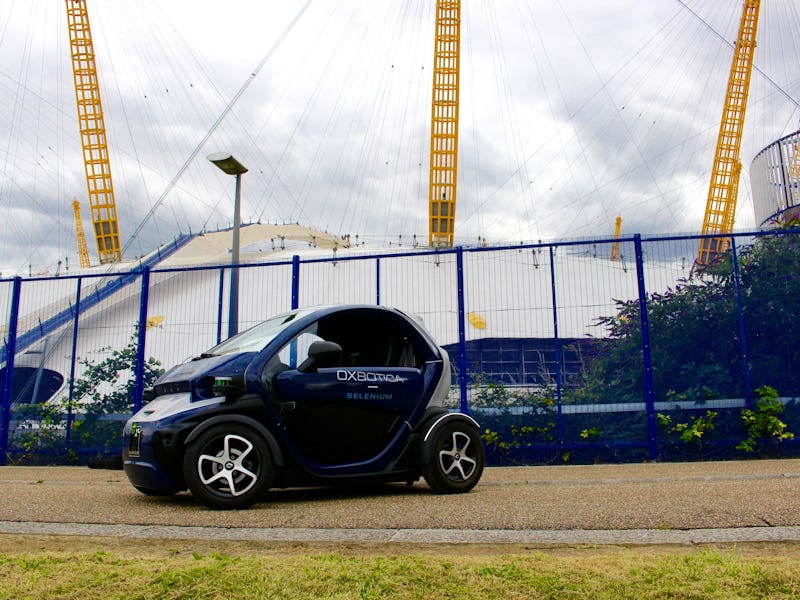A Fleet of Self-Driving Cars Will Test-Drive from Oxford to London
The 60-mile trip will take vehicles between Oxford and London.

The United Kingdom is about to play host to one of the most ambitious autonomous car tests ever. Its goal? To find out what happens when you let a fleet of self-driving cars loose into the real world.
The DRIVEN consortium is a government-funded group of companies involved in several aspects of autonomous car development, starting a 30-month test project that will culminate in six to 12 self-driving cars driving between London and Oxford in the second half of 2019. The project aims to go beyond the question of whether we can make a car drive itself, exploring bigger issues like how a computer can judge risk and what happens when an autonomous car loses cellular service.
The open-road testing will put to use the technology developed by Oxford-based artificial intelligence firm Oxbotica. The cars will operate with SAE Level 4 autonomy.
“This is the first exercise where there’s a connected fleet talking to each other about risk and routes and all those sorts of things,” Dr. Graeme Smith, CEO of Oxbotica, tells Inverse. “Typically, vehicles today work as single vehicles, so this is the first trial where we’re looking at doing some joined-up thinking between the different vehicles.”
The DRIVEN consortium has received an £8.6 million ($11.1 million) grant from Innovate UK, the government’s innovation agency, to pursue a 30-month plan that culminates in the 60-mile trials at the end.
This year, the team will start putting system-equipped vehicles in limited numbers on roads around Oxfordshire.
The actual route hasn't been set yet.
In early 2018, the team will start running the system autonomously, most likely on closed public roads to begin with, before demonstrating the system in other places by the middle of that year. Throughout the project, the cars will have a human driver ready to take over, but the collected data will lay the groundwork for a fully autonomous future.
This moment has been a long time coming. Oxbotica started life 10 years ago as an Oxford University autonomous car project, until around three years ago when it was spun off into its own company.
Beyond autonomous cars, elements of the team’s work are being used in the European Space Agency’s ExoMars program. The mission, set to start in 2020, will search the red planet for signs of organisms and report back, in a similar fashion to NASA’s Curiosity rover.
“They don’t have GPS on Mars, so the vehicles need to know where they are, so they use our camera localization system to figure out where they are, where they’ve been and how to control the vehicle,” Smith says. “It’s very exciting for the team to know that their tech is going off-planet!”
The system is designed to work with a variety of vehicles. Depending on the car and its application, the system uses between four and 10 cameras, a lidar sensor, and radar as a backup. Unlike Tesla, Oxbotica is not currently using an ultrasonic sensor due to its short range, but this could change in the future.
An Oxbotica trial vehicle.
An Intel Core i7 takes all this data and interprets it in real-time to drive the car. Many automakers use chips specially designed for autonomy, like the Nvidia Drive PX 2, but Oxbotica is taking a different approach that makes the Nvidia’s graphics-first design less suitable.
You may have noticed that GPS is missing from this list. The team is going for a sensors-only approach that will reduce the system’s dependence on wireless communications. Although cell carriers are touting the benefits of ultra-fast speeds, Oxbotica is already thinking about what happens if the car loses connectivity.
Cellular carrier Telefonica O2 is a consortium partner, and the cars will use 3G, 4G and 5G networks to communicate information between each other. But cell service is sometimes patchy: Oxbotica has devised an ingenious solution to avoid trouble.
“If one of the vehicles needs a map update in a certain area, it will know to ask for it when it’s got good connectivity, rather than just hopefully aniticpating it might be there when it’s got bad connectivity,” Smith says. The car will know which areas have bad service, or whether upcoming cell sites are experiencing heavy traffic, and plan accordingly.
The project will also help insurance firm XL Catin, another member of the consortium, develop a risk profiling tool. The end goal is to help insurance companies and manufacturers understand how much risk a specific model of autonomous car is under certain conditions. Driving in snow is likely to be riskier than driving in the sun, for example, but this tool will enable companies to better understand the differences and produce risk models accordingly.
“What we’re trying to do is collect lots of data that helps understand the risk of an autonomy session, and turn that into numbers we can use for insurance,” Smith says.
Beyond the above three companies, the consortium will help a wide range of firms plan for the autonomous future. These include Nominet, Transport Research Laboratory, the UK Atomic Energy Authority’s RACE, Oxfordshire County Council, Transport for London and Westbourne Communications.
After the trial, the team hopes to start talking with automakers about using the then-refined tools in shipping products. The U.K.’s autonomous car revolution is just getting started.